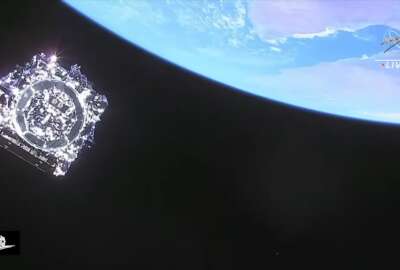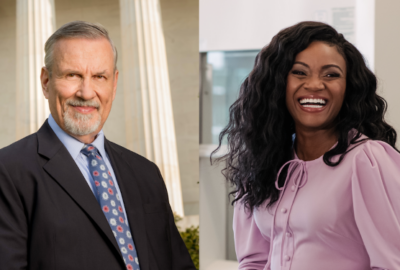Meet the guy who got fixed NASA’s big telescope and made sure it got into space
The James Webb Space Telescope has been sending back mind-bending data since its launch last year. But a few years ago the project was mired in trouble. More than a...
Best listening experience is on Chrome, Firefox or Safari. Subscribe to Federal Drive’s daily audio interviews on Apple Podcasts or PodcastOne.
The James Webb Space Telescope has been sending back mind-bending data since its launch last year. But a few years ago the project was mired in trouble. More than a decade late and billions of dollars over budget. My next came in and got it all back on track. He’s the James Webb program manager, and a finalist in this year’s Service to America Medals program. Gregory Robinson joined the Federal Drive with Tom Temin to discuss.
Interview transcript:
Tom Temin: Mr. Robinson, good to have you on.
Greg Robinson: Good morning, Tom. I’m glad to be here. And I appreciate you inviting me for this interview.
Tom Temin: And you are a longtime employee of NASA. So this sounds like just the latest in a series of challenges they like to throw at you?
Greg Robinson: Yes. So I’ve been around a long time, more than 30 years. And I came on Webb four years ago. And I’ve worked many we call spaceflight missions, including all of the space shuttle missions after the Columbia accident.
Tom Temin: Wow, we’ll wait for your book to come out. But in the meantime, let’s talk about what happened in 2018 when you got assigned to the James Webb, what did you find, first of all? And how did you devise a plan to go about getting it right?
Greg Robinson: I’ll start off saying that the development team is incredibly, incredibly smart, really smart individuals and team. So I didn’t have to worry about doing any hardcore analysis or engineering or anything like that. That was already in place. A couple areas certainly had to lay out the program to build confidence in our stakeholders that we could get it done. What was the budget needed? What was the schedule, what was the plan to make sure that happened? So that included looking at an independent review team recommendations, and weaving those into how we actually work. And so a couple areas of high interest, one was to mitigate human errors. So small errors on Webb meant many months, and many millions of dollars, in some cases, hundreds of millions. So we had to really mitigate human errors. And some of that is what I call adding fresh eyes, have someone else look at the product, particularly critical areas, occasionally bring in a small review team to review something in particular. So we did a lot of that. And I think it made a huge difference. The other one was transparency, transparency from the project up through headquarters to the administrative suite and of course the White House and Congress. And so I reinstated the quarterly meetings with Congress with all the floor committees, and with Office of Management and Budget. So sometimes I took them bad news. And as I took good news and bad news, and they rarely questioned whether I was transparent or not, and I think they made for happy marriage, we got all the support we needed. And that put us on our way.
Tom Temin: And with respect to the human errors and adding the fresh eyes, I guess it sounds like you were following one of the basic quality control principles. And that is the earlier you detect an error, the less expensive and faster it is to fix. So that if you take a couple of extra days or weeks now you might save months and millions later on. Was that a fair way to put it?
Greg Robinson: That’s absolutely correct. So there are a couple of types of issues you have. One is just the technical challenges. Sometimes the physics just get you, right, engineering design just gets you. And that’s the complexity of it. The team was fairly good at that. A few exceptions. The other ones were the lack of focus that caused there, these were not hard engineering type errors. So we definitely had to eliminate those, those were the easiest to eliminate, because other ones are just physics, they get you. But those became fewer and fewer as we went further.
Tom Temin: We are speaking with Greg Robinson, program director for the James Webb Space Telescope at NASA. And what was the morale like of that staff, which you described as very smart, but they were making errors. And you said, there’s a lack of focus. So it sounds like maybe as it dragged on, people were getting bored with it or what?
Greg Robinson: So I’ll start off sending human errors, called human induced errors, there weren’t a lot of them. And they weren’t that often, but the impacts were huge when they happened. So that’s the first thing. So in 2018, the morale was not great, especially when we had the independent review team come in and look at what was going on. No one wants to be reviewed independently. It’s just a fact of life. So it created a little contention in the environment. One of my challenges was really to embrace those recommendations. And all of them were very, very good. Some we did not implement exactly, but tried to implement what they were trying to get at, the intent. So I tried to fold those recommendations into the way we actually work day to day. So let’s not do a whole lot different. But let’s get better. And let’s make some small changes in some areas where we’re very good, but we need to get a little bit better. So as I made that change to not fight the recommendations, I think that helped us move along now reducing the contention in the system.
Tom Temin: What in your past assignments at NASA do you feel gave you the equipment to deal with this particular issue because it was getting a lot of publicity and a lot of impatience, as you say, especially from the appropriators?
Greg Robinson: As I mentioned before, I’ve worked many spaceflight missions on the science side, a lot of satellite missions, and heliophysics and earth science and astrophysics. And a little bit of planetary on the Mars side. I’ve touched a lot of missions, I’ve seen numerous developments, after a while, as you heard in the sports world, they said the game slows down, the pitch is not as fast as it used to be as I get a little more comfortable, a little more experienced. So it slows down now with those experiences. So you can kind of see things you know what to try to avoid, certainly doesn’t make you perfect. So those experiences really helped a lot. And then there’s an art side over the years with good training, good mentors were good development programs. And it helped shape some of the art side of working with organizations, building teams, leading teams, etc.
Tom Temin: So you came into this project with some credibility behind you.
Greg Robinson: At least that’s what they told me. I had a little bit. So yeah, I had a lot of experience, I’d been the deputy director of the Glenn Research Center, 3,200 employees, with many different types of missions, from spaceflight to aeronautics to research and technology development. I’ve dealt with the industrial base many of the companies for many, many years in different forms. So the game just slowed down for me.
Tom Temin: Got it. And on the day of the launch, late last year, what was it like? Because knowing how many billions of dollars and a couple of decades went into building this single copy of this instrument, and you only had one chance to get it into space correctly? What was that like?
Greg Robinson: Normally, I have butterflies going into the launch count. I must say they were less this time than ever. I’m not sure why. But I had a lot of confidence in the team, what they had accomplished. And the things we had put in place over the last four years gave me high confidence. I had high confidence in the rocket, Ariane 5. So I wasn’t really concerned, I just want to see some fire and smoke.
Tom Temin: Got it. Well, we saw that. And now with these images coming back, what’s your role in the James Webb now that it’s up and operational, and we’re seeing these great visualizations?
Greg Robinson: So we’re in the six month commissioning phase right now, six months after launch, we did all the deployments back in January, we’ve focused and align the mirror. And now we’re in the what we call the instrument, the science instrument commissioning phase for the next couple of months or so. We have about two months left, before we actually get into science operations mode. But we’ve already gotten back some amazing images of really bright stars, lots of galaxies. So we know the telescope was working, I would say almost perfectly, maybe perfectly and actually beyond what we expected. So I’m looking forward to the next couple of months, getting it ready so we can release some of these first science images to the world.
Tom Temin: And what will you do next? Any plans?
Greg Robinson: A couple of cartwheels if I still can. And I’m still still trying to decide what that is.
Tom Temin: Greg Robinson is the program director for the James Webb Space Telescope at NASA and a finalist in this year’s Service to America Medals Program. Thanks so much for joining me.
Greg Robinson: Thank you, Tom. I really appreciate it again. Thanks for having me. And go Webb.
Copyright © 2025 Federal News Network. All rights reserved. This website is not intended for users located within the European Economic Area.
Tom Temin is host of the Federal Drive and has been providing insight on federal technology and management issues for more than 30 years.
Follow @tteminWFED






